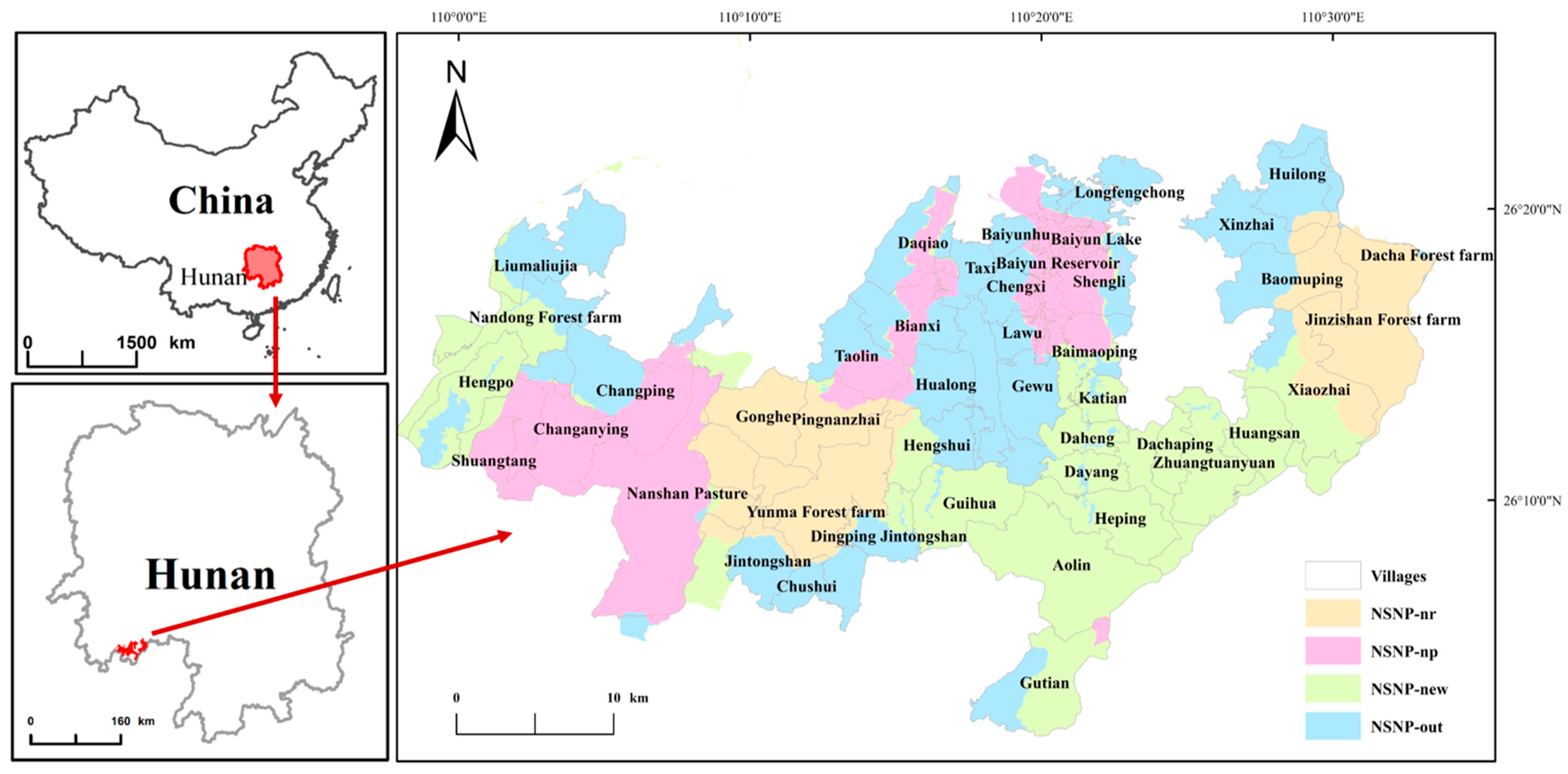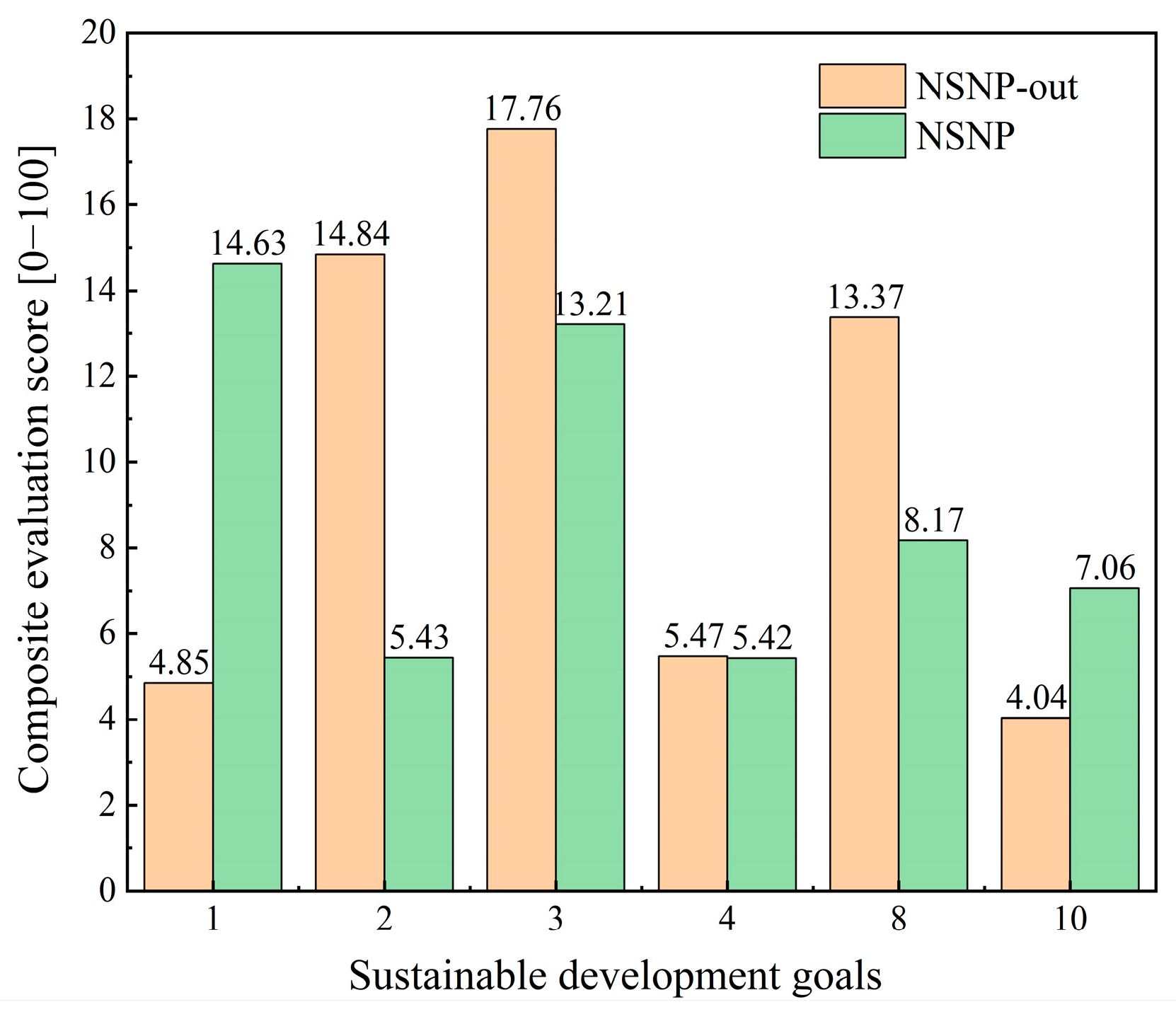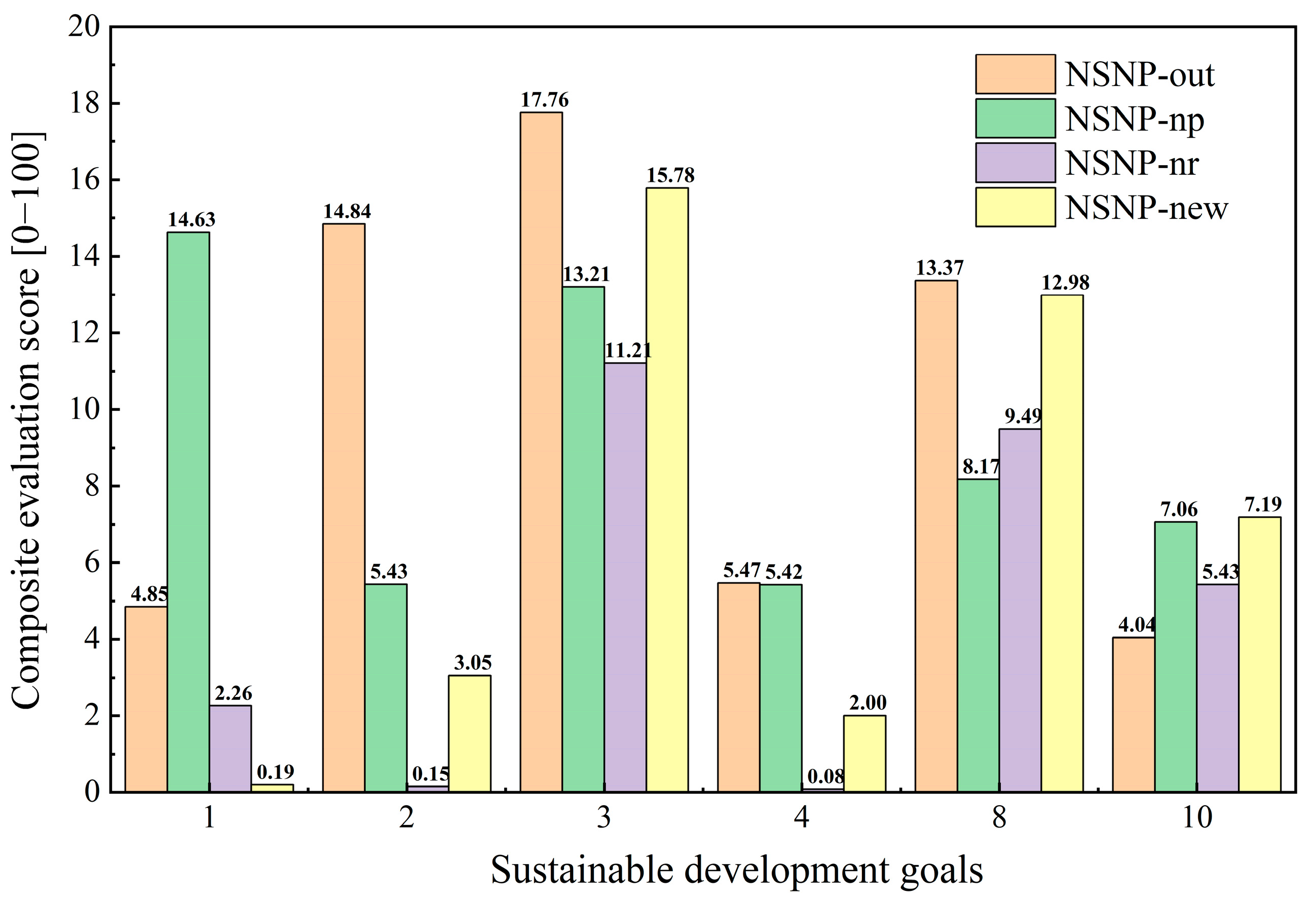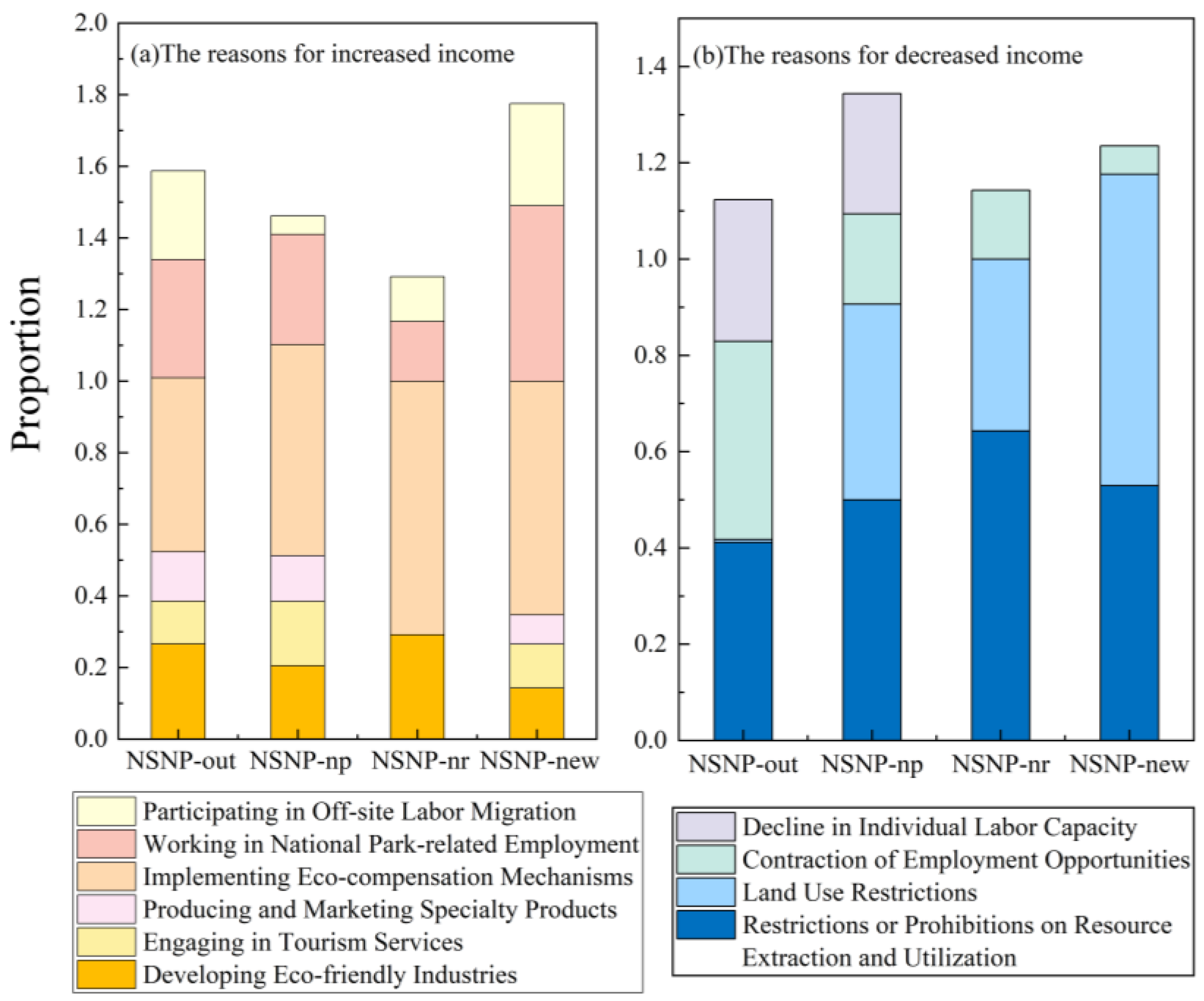Evaluating the Sustainable Development Level of Local Communities Within Hunan Nanshan National Park, China
Abstract
1. Introduction
2. Materials and Methods
2.1. Study Area
2.2. Community Sustainable Development Evaluation Index System of NSNP
2.3. Questionnaire Design and Collection
2.4. Determination of the Indicator Weight
2.4.1. Data Normalization
2.4.2. Entropy-Weighting Method
2.5. Comparison in Different Areas of National Parks
3. Results
3.1. Statistics of Survey Questionnaire Data
3.2. Community Sustainable Development Index Comprehensive Assessment
3.3. Comparison of Community Sustainable Development Index in Different Regions
4. Discussion
5. Conclusions
Supplementary Materials
Author Contributions
Funding
Data Availability Statement
Acknowledgments
Conflicts of Interest
References
- Zhao, X.; Su, H. The research framework and key issues of sustainable livelihoods in the national park. J. Nat. Resour. 2023, 38, 2217–2236. [Google Scholar] [CrossRef]
- Gao, J.; Liu, X.; Zhou, D.; Ma, K.; Wu, Q.; Li, G. Some opinions on the integration and optimization of natural protected areas in China. Biodivers. Sci. 2021, 29, 290–294. [Google Scholar] [CrossRef]
- Zhu, D.; Zhong, L.; Yu, H. Research progress of community development of national parks and implications. Resour. Sci. 2021, 43, 1903–1917. [Google Scholar] [CrossRef]
- He, S.; Wei, Y.; Su, Y.; Min, Q. Guaranteeing fair and sustainable benefit sharing for communities in the national park: A study from perception of meanings of social-ecological systems. Acta Ecol. Sin. 2020, 40, 2450–2462. [Google Scholar]
- Wang, M.; Wang, Y.; Dong, H.; Zhang, M.; Su, M. Review of the relationship between national park construction and sustainable community development from the perspective of sustainable livelihoods. Natl. Park. 2024, 2, 465–474. [Google Scholar]
- Zhang, Y.; West, P.; Thakholi, L.; Suryawanshi, K.; Supuma, M.; Straub, D.; Sithole, S.S.; Sharma, R.; Schleicher, J.; Ruli, B.; et al. Governance and Conservation Effectiveness in Protected Areas and Indigenous and Locally Managed Areas. Annu. Rev. Environ. Resour. 2023, 48, 559–588. [Google Scholar] [CrossRef]
- Stroupe, S.; Geremia, C.; Wallen, R.L.; White, P.J.; Derr, J.N. Genetic Reassessment of Population Subdivision in Yellowstone National Park Bison. J. Hered. 2025, 116, 1–9. [Google Scholar] [CrossRef]
- Atiqul Haq, S. Multi-Benefits of National Parks and Protected Areas: An Integrative Approach for Developing Countries. Environ. Socio-Econ. Stud. 2016, 4, 1–11. [Google Scholar] [CrossRef]
- Jacobs, B.; Boronyak, L.; Mitchell, P.; Vandenberg, M.; Batten, B. Towards a Climate Change Adaptation Strategy for National Parks: Adaptive Management Pathways under Dynamic Risk. Environ. Sci. Policy 2018, 89, 206–215. [Google Scholar] [CrossRef]
- Chun, J.; Kim, C.-K.; Kim, G.S.; Jeong, J.; Lee, W.-K. Social Big Data Informs Spatially Explicit Management Options for National Parks with High Tourism Pressures. Tour. Manag. 2020, 81, 104136. [Google Scholar] [CrossRef]
- Aiman, A.; Aziz, N.A.A.; Saadun, N.; Lin, E.L.A.; Lechner, A.M.; Azhar, B. Attitudes and Willingness of Local Communities towards Natural Urban Forest Conservation in a Rapidly Developing Southeast Asia City. Cities 2022, 129, 103832. [Google Scholar] [CrossRef]
- Tang, X.; Adesina, J.A. Biodiversity Conservation of National Parks and Nature-Protected Areas in West Africa: The Case of Kainji National Park, Nigeria. Sustainability 2022, 14, 7322. [Google Scholar] [CrossRef]
- Koshim, A.; Sergeyeva, A.; Kakimzhanov, Y.; Aktymbayeva, A.; Sakypbek, M.; Sapiyeva, A. Sustainable Development of Ecotourism in “Altynemel” National Park, Kazakhstan: Assessment through the Perception of Residents. Sustainability 2023, 15, 8496. [Google Scholar] [CrossRef]
- Poponi, S.; Palli, J.; Ferrari, S.; Filibeck, G.; Forte, T.; Franceschini, C.; Ruggieri, A.; Piovesan, G. Ecology and Society: Toward the Development of Sustainable Ecotourism in Italian National Parks of the Apennines: Insights from Hiking Guides. Ecol. Soc. 2020, 25, 46. [Google Scholar] [CrossRef]
- Bricker, K.S.; Lackey, N.Q.; Joyner, L. A Framework for Sustainable Tourism Development in and around National Parks. J. Park. Recreat. Adm. 2022, 40, 134–153. [Google Scholar] [CrossRef]
- Yang, D.; Liu, Q.; Yang, Z.; Song, J.; Chen, D. Spatiotemporal Dynamics of Human Ecosystems in the Context of Protected Areas as a Policy Tool: Insights from Sanjiangyuan National Park, China. Ecol. Indic. 2024, 165, 112196. [Google Scholar] [CrossRef]
- Huang, S.; Sheng, D.; Wang, P.; Xiao, J.; Li, Q.; Liu, H. Assessment of Ecotourism Suitability in Qilian Mountain National Park. Sci. Rep. 2025, 15, 19529. [Google Scholar] [CrossRef] [PubMed]
- Mitchell, R.; Wooliscroft, B.; Higham, J.E.S. Applying Sustainability in National Park Management: Balancing Public and Private Interests Using a Sustainable Market Orientation Model. J. Sustain. Tour. 2013, 21, 695–715. [Google Scholar] [CrossRef]
- Zhang, C.; Chen, W.; Huang, B.; Zhang, H.; Zhen, S.; Deng, R. Evaluation indicator system of national park tourism sustainability management: A case study of Selin Co-Puruogangri Glacier in Tibet. Acta Ecol. Sin. 2020, 40, 7299–7311. [Google Scholar]
- Guo, R.; Sun, Y.; Yu, H. Spatial coupling types of Qinghai-Tibet Plateau national park cluster and community sustainable development. Acta Ecol. Sin. 2023, 43, 5686–5698. [Google Scholar]
- Wei, D.; Liu, B.; Duan, Z.; Yang, W. Measuring Local Progress of the 2030 Agenda for SDGs in the Yangtze River Economic Zone, China. Environ. Dev. Sustain. 2022, 24, 7178–7194. [Google Scholar] [CrossRef]
- Zhu, Y.; Tian, D.; Yan, F. Effectiveness of Entropy Weight Method in Decision-Making. Expert. Syst. Appl. 2010, 37, 2517–2521. [Google Scholar] [CrossRef]
- Panchal, S.; Shrivastava, A.K. Landslide Hazard Assessment Using Analytic Hierarchy Process (AHP): A Case Study of National Highway 5 in India. Ain Shams Eng. J. 2022, 13, 101626. [Google Scholar] [CrossRef]
- Luo, H.; Ming, D.; Xu, L.; Ling, X. Tree Species Classification Based on ASDER and MALSTM-FCN. Remote Sens. 2023, 15, 1723. [Google Scholar] [CrossRef]
- Zheng, Q.; Chen, Z.; Chen, Y.; Hong, X. Research on the Evaluation of Recreation Suitability of National Parks Based on Ecological Sensitivity Constraints: A Case Study of Nanshan National Park. Ecol. Econ. 2024, 40, 119–127. [Google Scholar]
- Zou, L.N.; Zhou, Y. Hunan’s First National Park Is About to Emerge. Hunan Daily, 17 September 2024; 3. [Google Scholar] [CrossRef]
- Tan, S. Farmers participate in the concession of Nanshan National Park Research on income impact and policy perception of perception by. Cent. South Univ. For. Technol. 2022. [Google Scholar] [CrossRef]
- Shi, S.; Liu, G. Spatial Matching Relationship between Health Tourism Destinations and Population Aging in the Yangtze River Delta Urban Agglomeration. Environ. Res. Commun. 2023, 5, 095001. [Google Scholar] [CrossRef]
- United Nations. SDG Indicators: Global Indicator Framework for the Sustainable Development Goals and Targets of the 2030 Agenda for Sustainable Development; United Nations: New York, NY, USA, 2017. [Google Scholar]
- Wang, H.J.; Lan, Z.M. Construction and Measurement of Urban Sustainable Development Indicator System in China. Commer. Econ. Res. 2022, 7, 184–188. [Google Scholar]
- Jin, Z.H.U.; Ying, P.A.N.; Zhongxu, Z.; Zhennan, L.I.; Junxi, W.U. The Impacts of Relocation on the Livelihoods among Different Agro-Pastoralist Groups in an Immigrated Village in Tibet. J. Resour. Ecol. 2022, 13, 888–896. [Google Scholar] [CrossRef]
- General Office of the CPC Central Committee; General Office of the State Council. Guiding Opinions on Establishing a Nature Reserve System with National Parks as the Mainstay. 2019. Available online: https://www.gov.cn/zhengce/2019-06/26/content_5403497.htm (accessed on 13 December 2024).
- Zhu, J.; Sun, X.; He, Z. Research on China’s sustainable development evaluation indicators in the framework of SDGs. China Popul. Resour. Environ. 2018, 28, 9–18. [Google Scholar]
- Xu, Z.; Chau, S.N.; Chen, X.; Zhang, J.; Li, Y.; Dietz, T.; Wang, J.; Winkler, J.A.; Fan, F.; Huang, B.; et al. Assessing Progress towards Sustainable Development over Space and Time. Nature 2020, 577, 74–78. [Google Scholar] [CrossRef]
- Shao, C.; Zhan, X.; Chen, S. Evaluation index system of rural sustainable development based on SDGs. China Popul. Resour. Environ. 2023, 33, 21–31. [Google Scholar]
- Du, X.; Zhou, J.; Xiao, C. Spatial Effects and Influencing Factors of Urban Sustainable Development: An Analysis of Urban Agglomerations in China. Econ. Anal. Policy 2024, 81, 556–575. [Google Scholar] [CrossRef]
- Lan, G.; Xiao, Y.; Ci, X.; Zhang, Y.; Xia, J. Spatial and Temporal Differentiation Characteristics of Green Development Levels in Urban Agglomerations within the Yangtze River Economic Belt and Analysis of Influencing Factors. Ecol. Indic. 2024, 166, 112552. [Google Scholar] [CrossRef]
- Siddiqui, A.; Altekar, S.; Kautish, P.; Fulzele, S.; Kulkarni, N.; Siddiqui, M.; Bashir, M.F. Review of Measurement of Sustainable Development Goals: A Comprehensive Bibliometric and Visualized Analysis. Environ. Sci. Pollut. Res. 2023, 30, 91761–91779. [Google Scholar] [CrossRef]
- Wang, Q.; Wang, S.; Chen, Y.; Chen, H.; Huang, R. Measurement, Regional Differences and Influencing Factors of SDGs-oriented Sustainable Development Level, in Anhui Province. Resour. Environ. Yangtze Basin 2025, 34, 71–86. [Google Scholar]
- Zhang, M.; Xiao, H.; Sun, D.; Li, Y. Spatial Differences in and Influences upon the Sustainable Development Level of the Yangtze River Delta Urban Agglomeration in China. Sustainability 2018, 10, 411. [Google Scholar] [CrossRef]
- Chen, Z. Research on the Cognition, Attitude and Behavior of Indigenous Peoples Towards Wildlife Conflicts: A Case Study of Wuyishan National Park. Master’s Thesis, Fujian Normal University, Fuzhou, China, 2023. [Google Scholar] [CrossRef]
- Ma, B.; Zeng, W.; Xie, Y.; Wang, Z.; Hu, G.; Li, Q.; Cao, R.; Zhuo, Y.; Zhang, T. Boundary Delineation and Grading Functional Zoning of Sanjiangyuan National Park Based on Biodiversity Importance Evaluations. Sci. Total. Environ. 2022, 825, 154068. [Google Scholar] [CrossRef]
- Zhu, H.; Zhao, M. Impact of National Parks on Livelihood and Income Structure of Different Types of Forestry Workers’Family: A Case Study of Northeast Tiger and Leopard National Park. J. Agro-For. Econ. Manag. 2022, 21, 78–86. [Google Scholar]
- Li, X.; Wei, Y.; Zhang, C.; Huang, B. How to balance ecological protection and community development in national parks: International experiences and China’s exploration. Natl. Park. 2023, 1, 44–52. [Google Scholar]
- Zeng, S.; Wang, H.; Xu, W.; Wu, J.; Wu, L. Pilot practice and experience of Xizang National Grassland Nature Parks under the nature reserve system. Tibet. Sci. Technol. 2024, 46, 18–22. [Google Scholar]
- He, S. The role of communities in the governance of China’s national parks and the consolidation and development of their role. J. Nat. Resour. 2024, 39, 2310–2334. [Google Scholar] [CrossRef]
- Thiermann, I.; Bittmann, T. Should I Stay or Should I Go? The Impact of Nature Reserves on the Survival and Growth of Dairy Farms. J. Environ. Manag. 2023, 328, 116993. [Google Scholar] [CrossRef]
- Akbar, I.; Yang, Z. The Influence of Tourism Revenue Sharing Constraints on Sustainable Tourism Development: A Study of Aksu-Jabagly Nature Reserve, Kazakhstan. Asian Geogr. 2022, 39, 133–153. [Google Scholar] [CrossRef]
- Al-Tokhais, A.; Thapa, B. Stakeholder Perspectives Towards National Parks and Protected Areas in Saudi Arabia. Sustainability 2019, 11, 2323. [Google Scholar] [CrossRef]
- Chen, Y.; Qiu, Y. Insights from Global Conservation Area Practices for China’s Protected Area Development. Archit. Cult. 2024, 11, 281–283. [Google Scholar] [CrossRef]
- Wu, B.X. Wuyishan National Park: Resonance of Ecological Welfare and Livelihood Security. Green. China 2024, 19, 42–45. [Google Scholar]
- Zhang, D.; Zhang, W.; Tan, Z. Problems and Recommendations in the Pilot Reform of Giant Panda National Park System: A Case Study of Maoxian Management Station. Sichuan Agric. Sci. Technol. 2024, 10, 126–129. [Google Scholar]
- Zhou, R.; Zhong, L.; Yu, H. Community perception towards Qianjiangyuan National Park System Pilot Area administrative measures. Resour. Sci. 2017, 39, 40–49. [Google Scholar]
- Lou, R. Ecological Product Value Realization Pathways in Hainan Tropical Rainforest National Park. New Orient. 2024, 6, 15–22. [Google Scholar]





| Goal Layer | Criterion Layer | Index Layer | Assignment Criteria | Properties | SDGs |
|---|---|---|---|---|---|
| Evaluation System for Sustainable Development of National Park Communities | Social layer | Minimum living allowance rate | The proportion of residents receiving minimum living allowance to the total population | − | 1 |
| Insurance participation rate for commercial insurance | The proportion of people who have purchased commercial insurance to the total population of the region | + | 1 | ||
| Residents’ physical health conditions | Unable to work = 0; Chronic illness = 0.25; Frequently ill = 0.5; Occasionally ill = 0.75; Very good health = 1 | + | 3 | ||
| The percentage of residents who are satisfied with the village medical services | The proportion of surveyed residents who are satisfied with the village medical services in the total number of surveyed individuals | + | 3 | ||
| The level of happiness of residents compared to before the establishment of the NSNP | Significantly reduced = 0; Modestly declined = 0.25; Remained stable = 0.5; Modestly improved = 0.75; Significantly increased = 1 | + | 3 | ||
| Educational Attainment | Illiterate = 0; Primary school/Junior high school = 0.25; High school/Vocational school = 0.5; Bachelor’s degree = 0.75; Graduate degree or above = 1 | + | 4 | ||
| Household Migrant Labor Ratio | The proportion of family members working outside the home to the total number of family laborers | − | 8 | ||
| Ecological Compensation | The proportion of families that received ecological compensation from the government among the total residents of the national park | + | 10 | ||
| Gini coefficient | The percentage of the total residents’ income that is used for unequal distribution in the total income. | − | 10 | ||
| Economic layer | Annual family income | Less than 5000 yuan = 0; 5000–10,000 yuan = 0.25; 10,000–20,000 yuan = 0.5 20,000–30,000 yuan = 0.75; More than 30,000 yuan = 1. | + | 2 | |
| Livelihood types | None or one type = 0.2; two types = 0.4; three types = 0.6; four types = 0.8; five or more types = 1 | + | 8 | ||
| Non-farm Income Share | The proportion of non-agricultural income from household activities in the total income | + | 8 |
| Goal Layer | Criterion Layer | Index Layer | Entropy | Utility Degree | Weight of Criterion Layer (%) | Weight of Criterion (%) | SDGs |
|---|---|---|---|---|---|---|---|
| Evaluation system and index weight for sustainable development of Nanshan National Park Communities | Social layer | Minimum living allowance rate (S1) | 0.764 | 0.236 | 74.032 | 9.679 | 1 |
| Insurance participation rate for commercial insurance (S2) | 0.773 | 0.227 | 9.326 | 1 | |||
| Residents’ physical health conditions (S3) | 0.737 | 0.263 | 10.791 | 3 | |||
| The percentage of residents who are satisfied with the village medical services (S4) | 0.83 | 0.17 | 6.983 | 3 | |||
| The level of happiness of residents compared to before the establishment of the NSNP (S5) | 0.698 | 0.302 | 12.372 | 3 | |||
| Educational Attainment (S6) | 0.803 | 0.197 | 8.103 | 4 | |||
| Household Migrant Labor Ratio (S7) | 0.893 | 0.107 | 4.387 | 8 | |||
| Ecological Compensation (S8) | 0.851 | 0.149 | 6.102 | 10 | |||
| Gini coefficient (S9) | 0.847 | 0.153 | 6.289 | 10 | |||
| Economic layer | Annual family income (E1) | 0.642 | 0.358 | 25.968 | 14.695 | 2 | |
| Livelihood types (E2) | 0.893 | 0.107 | 4.380 | 8 | |||
| Non-farm Income Share (E3) | 0.832 | 0.168 | 6.893 | 8 |
| Income Change | Revenue Improvement | No Change | Income Reduction | |
|---|---|---|---|---|
| NSNP-out | 58.29% | 32.62% | 9.09% | |
| NSNP-inside | Total | 51.85% | 18.98% | 29.17% |
| NSNP-np | 42.39% | 22.83% | 34.78% | |
| NSNP-nr | 51.06% | 19.15% | 29.79% | |
| NSNP-new | 63.64% | 14.29% | 22.08% | |
Disclaimer/Publisher’s Note: The statements, opinions and data contained in all publications are solely those of the individual author(s) and contributor(s) and not of MDPI and/or the editor(s). MDPI and/or the editor(s) disclaim responsibility for any injury to people or property resulting from any ideas, methods, instructions or products referred to in the content. |
© 2025 by the authors. Licensee MDPI, Basel, Switzerland. This article is an open access article distributed under the terms and conditions of the Creative Commons Attribution (CC BY) license (https://creativecommons.org/licenses/by/4.0/).
Share and Cite
Bai, L.; Chen, Y.; Cui, Y.; Feng, C.; Wu, C.; Ma, B.; Zhao, W.; Duan, C.; Wang, W. Evaluating the Sustainable Development Level of Local Communities Within Hunan Nanshan National Park, China. Land 2025, 14, 1749. https://doi.org/10.3390/land14091749
Bai L, Chen Y, Cui Y, Feng C, Wu C, Ma B, Zhao W, Duan C, Wang W. Evaluating the Sustainable Development Level of Local Communities Within Hunan Nanshan National Park, China. Land. 2025; 14(9):1749. https://doi.org/10.3390/land14091749
Chicago/Turabian StyleBai, Lu, Yan Chen, Yaping Cui, Chunting Feng, Chen Wu, Bingran Ma, Weiyang Zhao, Chenxingyu Duan, and Wei Wang. 2025. "Evaluating the Sustainable Development Level of Local Communities Within Hunan Nanshan National Park, China" Land 14, no. 9: 1749. https://doi.org/10.3390/land14091749
APA StyleBai, L., Chen, Y., Cui, Y., Feng, C., Wu, C., Ma, B., Zhao, W., Duan, C., & Wang, W. (2025). Evaluating the Sustainable Development Level of Local Communities Within Hunan Nanshan National Park, China. Land, 14(9), 1749. https://doi.org/10.3390/land14091749








